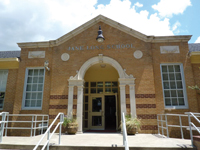A LITTLE PIECE OF HISTORY | By Joan Frances-

Jane Long Elementary School
One to three percent of the United States’ population is affected by mental disabilities. Children who were diagnosed before age 18 with below average general intellectual function and lack of social skills warrant special education. The history of mentally delayed children is filled with misconceptions and rejections.
For many years, families were compelled to incarcerate their loved ones, forcing them to live in dehumanizing environments with no positive outcome, as education was considered impossible for them. Little to no progress was made until the early part of the 20th century, when devoted parents consistently formed advocacy groups to encourage public awareness for educating children with disabilities.
In 1961, President John F. Kennedy approved federal aid to create the President’s Panel on Mental Retardation. Despite this effort, only a small number of special education children attended public schools. Finally, in 1975, when The Education for All Handicapped Children Act (EHA) and the Individuals with Disabilities Education Act (IDEA) were implemented, states that accepted public funds for education had to provide special education to qualifying children with disabilities. This set into motion the evolution of properly teaching children with special needs.
Over the past 50 years, public education has continued to place emphasis on preparing all students to take the next step in society. Jane Long Elementary School in Lamar Consolidated Independent School District (LCISD) has established a successful reputation for teaching these students in a safe and positive environment.
When a child is identified with special needs, a committee, including parents, teachers and an administrator, meets at least once a year and decides how to best help the student. It is crucial that the student is served in the least restrictive environment. For some students, this means that they stay in the general education classroom and have tutoring to assist them with concepts they are struggling with. A special education teacher or aide may come into the classroom and help them. This is called inclusion, and the goal is to have each student exposed to the state Texas Essential Knowledge and Skills (TEKS) and curriculum as much as possible.

The Lamar Consolidated ISD Special Needs Center, located across the street from Jane Long Elementary, is the meeting place for all special education programs in the school district.
Other students may need more intensive help, and they are placed into a small group setting to help them master educational concepts. This is referred to as a resource setting. It is important that the special education teacher becomes an advocate for students and makes sure they are being educated in a way that allows them to become and feel successful. A good special education teacher focuses on what their students can do rather than what they can’t do.
The Social Integration Program (SIP) at Jane Long Elementary is constantly evolving to better meet the needs of the young LCISD community. Currently, SIP provides a centralized classroom setting for students with exceptionalities. Students enrolled in SIP require specialized teaching strategies, a significantly modified curriculum aligned with grade level TEKS and ongoing development of social skills and behavior skills. The program focuses on social interaction skills, behavior skills and personal independence skills with the goal of an inclusive education setting at the primary level.
Jane Long Elementary hopes to continue to raise the bar with its special education program. The district helps teachers with training and accessing current research and effective strategies that have been proven effective for special needs students. The goal is to help these students make gains in their cognitive and social growth, which will in turn help them become successful and more confident as they continue progressing in society.